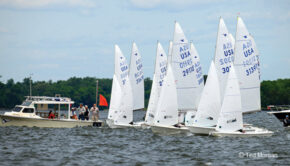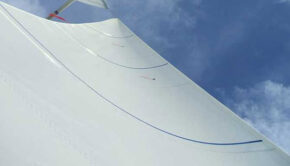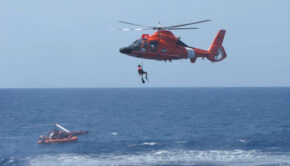Stories from the Street: Man Overboard
Published on April 3rd, 2014
Donald Street Jr. is somewhere north of 80 years old, and has swallowed more salt water than most of us will ever sail on. Here he shares his opinion on what to do when a person goes overboard…
Losing a person overboard and successfully retrieving them is like the World War 1 bi-plane pilot. Any landing you can walk away from was a good one.
If the man overboard has been retrieved, the boat and crew obviously did it right under the conditions they were operating, and with the crew and equipment available.
On the engine-less Iolaire, the standard orders if a crew went overboard is quick stop, helm down head to wind, toss over the MOB gear which can be launched almost instantly.
The MOB gear consists of about a 20′ pole, flag at top, weight on bottom, attached via a lanyard to life ring that had a sea anchor attached to it and a strobe light (today a small EPIRB would be attached). This was stowed on the backstays port and starboard. This system was installed on Iolaire in 1963 and is still there today.
Two reasons for the quick stop. At 6 knots of boat speed, in one minute the boat travels 200 yards. Unless the boat is stopped, even if the MOB gear is launched in a minute, the gear is 200 yard from the crew in the water.
Iolaire’s poles stowed port and starboard on the backstays (she has two permanent backstays as advocated by the late J Laurent Giles and Captain John Illingworth; see illustration) can be launched almost instantly.
How long does it take to launch one of the inflatable MOB rigs? Test and multiply minutes by 200 yards and you will see why I and many others urge the quick stop method.
Second reason for going head to wind, is if sailing downwind with a proper preventer rigged, the boat will stop. If the helmsman is good, he or she will get sternway on and once the preventer is thrown off, the boat will fall off on the opposite tack heading back to the crew member in the water.
If reaching or beating, slamming helm down will bring the boat head to wind, the headsail will be aback and throw the boat on the opposite tack heading back to the MOB. Sails can then be trimmed and boat maneuvered to the MOB.
In the 1935 Transatlantic Race to Norway, Vamarie a wishbone ketch, was sailing downwind, with the wishbone, boomed main staysail, and mizzen all held in place by preventers. Getting ready to set the spinnaker, the professional Captain went overboard. The late C Sherman Hoyt (the man that saved America’s Cup in the Rainbow Endeavor 1 contest, but that is another story) was on the helm.
Hoyt put Vamarie head to wind, gathered sternway and once the vangs were thrown off, fell off on starboard tack, sailed back to the skipper that they fished out of the water. The skipper had been wearing HIP BOOTS. He had managed to shed one, and after being rescued for the rest of the race he complained that he always had one wet foot!
I feel that every boat should have a MOB rig as per Iolaire, see drawing, but also a water activated small EPIRB should be attached. Had the Clipper Race crew onboard Derry~Londonderry~Doire had Iolaire MOB rig with small EPIRB attached, and if MOB gear was immediately deployed, it would have simplified the search.
I feel ALL boats sailing offshore, and especially race boats, should have MOB rig like Iolaire but with small EPIRB also attached.
As for inflatable MOB rigs, test how long it takes to launch and inflate. Remember at 6 knots, the boat is traveling 200 yards per minute.
Best advice is to avoid the problem and don’t fall overboard. Additional information is in the article STAYING ON BOARD in the May 2014 edition of Cruising World magazine.









 We’ll keep your information safe.
We’ll keep your information safe.